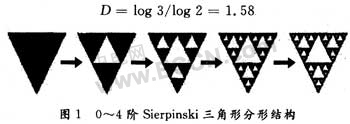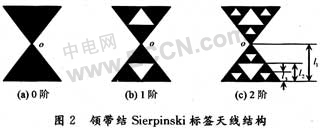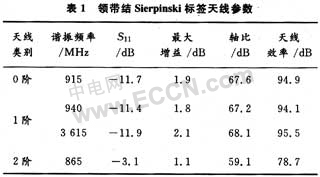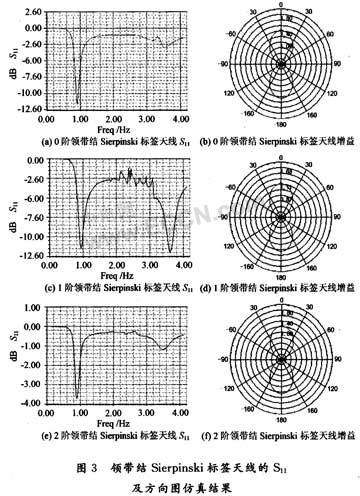RFID tag antenna based on tie knot Sierpinski fractal structure
Radio frequency identification (Radio Frequency IdenTIficaTIon, RFID) technology is an automatic identification technology that emerged in the 1990s. The technology uses wireless radio frequency for two-way communication, and achieves the purpose of identifying targets and data exchange within a certain working distance. Compared with other magnetic card, IC card and other identification technologies, the biggest advantage of radio frequency identification technology is that it works in a non-contact manner, which can be called the third generation of automatic identification technology.
From the operating frequency of the system, the RFID system can be divided into low frequency (LF), high frequency (HF), ultra high frequency (UHF), microwave and other frequency bands. Among them, low-frequency and high-frequency RFID systems have been widely used in many fields such as door locks, smart cards, and libraries, and their technologies have also been relatively mature. As for the UHF RFID system, it has received more attention because of its advantages such as longer reading distance, faster reading speed, and multi-target rapid recognition. In recent years, with the success of UHF RFID technology in many occasions-logistics and supply management, manufacturing and assembly, luggage / parcel tracking, library management, ID card identification, sports timing, access control systems, automatic highway toll collection, etc. The pilot has shown its broad application prospects.
An RFID system consists of two parts: a reader and an electronic tag. Among them, the antenna plays an important role in readers and electronic tags. He is used to transmit and receive signals, and is responsible for the important task of coupling energy into electronic tag chips. Therefore, the design of the electronic tag antenna directly affects the identification distance of the electronic tag and determines the identification rate of the entire system. However, there are few reports on the research of electronic tag antennas. In the RFID system, because the electronic tag needs to be attached to the identified and object as the identity symbol of the identified object, and due to the diversity of the identified object, people have put forward high requirements on the antenna of the electronic tag, which is mainly reflected in In the wide frequency range of the electronic tag, the volume of the antenna is smaller, it is easy to install and carry, and the antenna is also required to have high efficiency. The design of the antenna depends largely on the operating frequency of the antenna. However, there are many types of antennas with a wide operating bandwidth, such as helical antennas, log periodic antennas, horn antennas, etc. These antennas have a fractal sense in a certain sense The correspondence between self-similarity in theory, the self-similarity of fractal geometry and the operating frequency of the antenna is of great significance to the design of the antenna.
In response to these needs, this paper introduces the tag antenna based on the tie knot Sierpinski Gasket fractal structure, and compares the resonance frequency and S11 characteristics of tag antennas with different fractal dimensions, and selects the tag antenna suitable for the RFID system And analyzed the correspondence between its port characteristics and the fractal self-similar structure.
In this paper, a Sierpinski fractal antenna and a tie-junction antenna are combined, and a tie-junction Sierpinski fractal electronic tag antenna is proposed. From the simulation results, it can be seen that due to the self-similarity of the fractal structure, the high-order structure Si-erpinski tie junction The antenna shows the operating characteristics of multiple frequency bands. At the same time, because of its simple structure and suitable for printing, this antenna form is particularly suitable as an electronic tag antenna in RFID systems.
2 Sierpinski fractal antenna characteristics
The Sierpinski triangle fractal structure is constructed by repeatedly removing an inverted equilateral triangle in sequence from an equilateral triangle. As shown in Figure 1, the fractal dimension of the Sierpinski triangle fractal structure is:

As can be seen from Figure 1, the total area of ​​the Sierpinski antenna profile remains unchanged. As the iteration order increases, the internal blank area gradually increases. Therefore, it has the opposite of the space-filling characteristics of the Hilbert fractal antenna mentioned in [2]. The internal blank interval is expandable.
3 tie knot Sierpinski fractal tag antenna structure
According to the Sierpinski fractal structure in FIG. 2, this paper proposes the tie-tie Sierpinski tag antenna structure shown in FIG. 2. 
4 Tie Knot Sierpinski Fractal Tag Antenna Analysis
According to the fractal structure in Fig. 2, a tie-tie antenna based on the fractal structure of two equilateral triangles Sierpinski Gasket is carved on a dielectric substrate with εr = 2.2 and h0 = 1 mm, and the position of the feeding point is set as in Fig. 2 O point in the. The dimensions l1 = 48 mm, l2 = 24 mm, and l3 = 12 mm were selected. At this time, the resonance frequency of the 0-order tie-tie Sierpinski tag antenna is 915 MHz. The HFSS method is used to simulate each antenna in FIG. 2. The results are shown in FIG. 3 and the antenna parameters are shown in Table 1.

It can be seen from Figure 3 and Table 1:
(1) For an ideal dipole fractal antenna, as the fractal order increases, it will exhibit multi-band characteristics. In the first-order fractal structure, a resonance point f = 940 MHz is generated at the low end, and a resonance point f = 3.615 MHz is also generated at the high end, with better efficiency and broadband characteristics.
(2) It can also be seen from the changes from 0 to 1 that the pattern and gain of the tag antenna have not changed much, and still maintain good performance, which not only can meet the requirements of the tag multi-band, but also The cost reduction is also very meaningful.
(3) However, with the increase of the fractal order, the gain and radiation efficiency of the antenna show a downward trend at the low end, which shows that obtaining multiple frequency bands through fractal comes at the cost of reducing part of the gain and efficiency. 
5 Conclusion
The tag antenna based on the tie knot Sierpinski Gasket fractal structure has the expandability of the internal blank interval. With the increase of the order, while ensuring the characteristics of multiple frequency bands, it effectively keeps the antenna gain and efficiency from sharply decreasing. With this fractal tag antenna, a multi-band high-efficiency RFID tag antenna can be realized, which is beneficial to the scale of production and the popularization of RFID.
Carbon Fiber Propeller, Folding Propeller For Drone, Multi Rotor Propeller
Carbon Fiber Propeller, Folding Propeller For Drone, Multi Rotor Propeller
shenzhen GC Electronics Co.,Ltd. , https://www.jmrdrone.com
